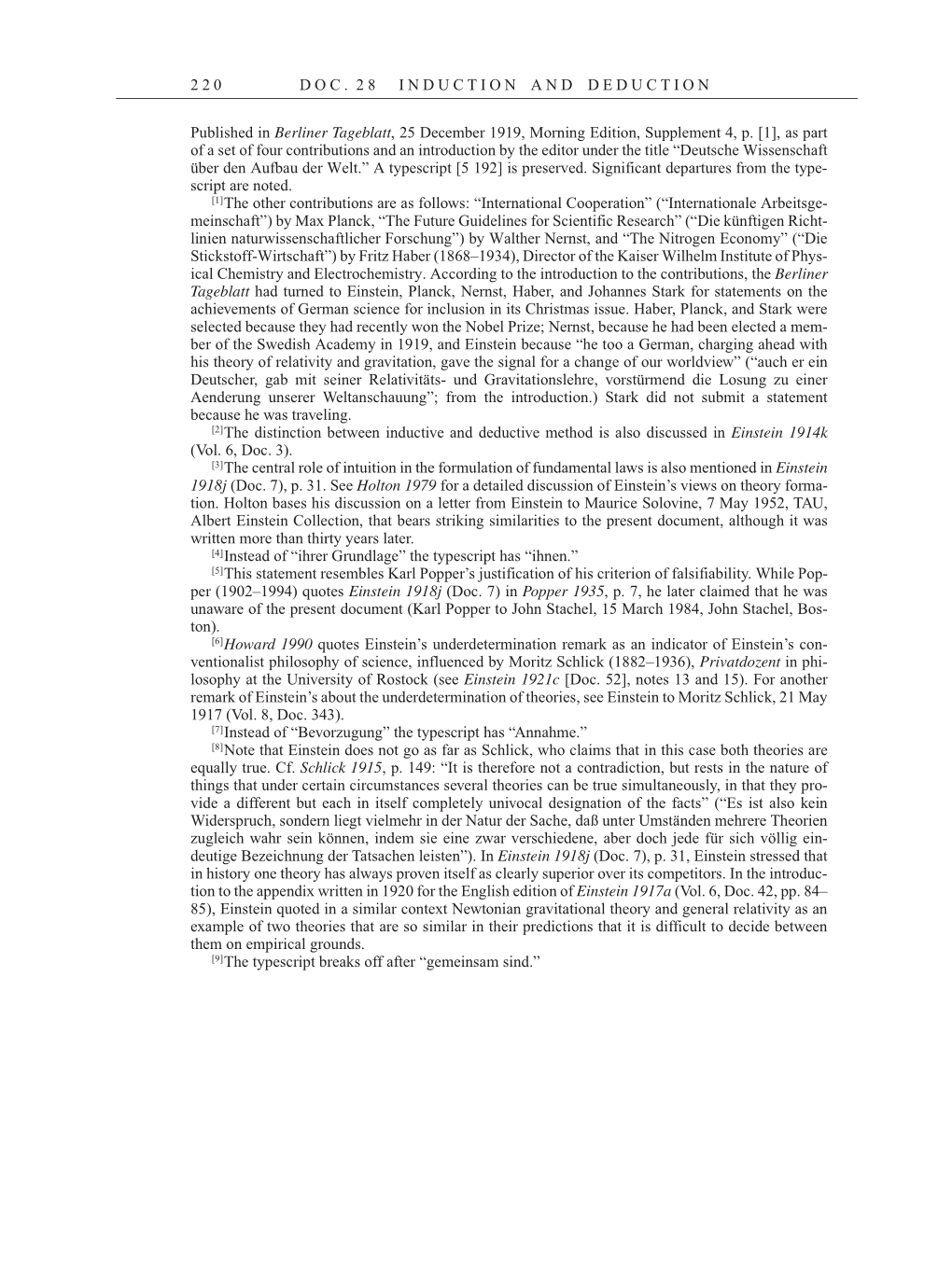2 2 0 D O C . 2 8 I N D U C T I O N A N D D E D U C T I O N
Published in Berliner Tageblatt, 25 December 1919, Morning Edition, Supplement 4, p. [1], as part
of a set of four contributions and an introduction by the editor under the title “Deutsche Wissenschaft
über den Aufbau der Welt.” A typescript [5 192] is preserved. Significant departures from the type-
script are noted.
[1]The other contributions are as follows: “International Cooperation” (“Internationale Arbeitsge-
meinschaft”) by Max Planck, “The Future Guidelines for Scientific Research” (“Die künftigen Richt-
linien naturwissenschaftlicher Forschung”) by Walther Nernst, and “The Nitrogen Economy” (“Die
Stickstoff-Wirtschaft”) by Fritz Haber (1868–1934), Director of the Kaiser Wilhelm Institute of Phys-
ical Chemistry and Electrochemistry. According to the introduction to the contributions, the Berliner
Tageblatt had turned to Einstein, Planck, Nernst, Haber, and Johannes Stark for statements on the
achievements of German science for inclusion in its Christmas issue. Haber, Planck, and Stark were
selected because they had recently won the Nobel Prize; Nernst, because he had been elected a mem-
ber of the Swedish Academy in 1919, and Einstein because “he too a German, charging ahead with
his theory of relativity and gravitation, gave the signal for a change of our worldview” (“auch er ein
Deutscher, gab mit seiner Relativitäts- und Gravitationslehre, vorstürmend die Losung zu einer
Aenderung unserer Weltanschauung”; from the introduction.) Stark did not submit a statement
because he was traveling.
[2]The distinction between inductive and deductive method is also discussed in Einstein 1914k
(Vol. 6, Doc. 3).
[3]The central role of intuition in the formulation of fundamental laws is also mentioned in Einstein
1918j (Doc. 7), p. 31. See Holton 1979 for a detailed discussion of Einstein’s views on theory forma-
tion. Holton bases his discussion on a letter from Einstein to Maurice Solovine, 7 May 1952, TAU,
Albert Einstein Collection, that bears striking similarities to the present document, although it was
written more than thirty years later.
[4]Instead of “ihrer Grundlage” the typescript has “ihnen.”
[5]This statement resembles Karl Popper’s justification of his criterion of falsifiability. While Pop-
per (1902–1994) quotes Einstein 1918j (Doc. 7) in Popper 1935, p. 7, he later claimed that he was
unaware of the present document (Karl Popper to John Stachel, 15 March 1984, John Stachel, Bos-
ton).
[6]Howard 1990 quotes Einstein’s underdetermination remark as an indicator of Einstein’s con-
ventionalist philosophy of science, influenced by Moritz Schlick (1882–1936), Privatdozent in phi-
losophy at the University of Rostock (see Einstein 1921c [Doc. 52], notes 13 and 15). For another
remark of Einstein’s about the underdetermination of theories, see Einstein to Moritz Schlick, 21 May
1917 (Vol. 8, Doc. 343).
[7]Instead of “Bevorzugung” the typescript has “Annahme.”
[8]Note that Einstein does not go as far as Schlick, who claims that in this case both theories are
equally true. Cf. Schlick 1915, p. 149: “It is therefore not a contradiction, but rests in the nature of
things that under certain circumstances several theories can be true simultaneously, in that they pro-
vide a different but each in itself completely univocal designation of the facts” (“Es ist also kein
Widerspruch, sondern liegt vielmehr in der Natur der Sache, daß unter Umständen mehrere Theorien
zugleich wahr sein können, indem sie eine zwar verschiedene, aber doch jede für sich völlig ein-
deutige Bezeichnung der Tatsachen leisten”). In Einstein 1918j (Doc. 7), p. 31, Einstein stressed that
in history one theory has always proven itself as clearly superior over its competitors. In the introduc-
tion to the appendix written in 1920 for the English edition of Einstein 1917a (Vol. 6, Doc. 42, pp. 84–
85), Einstein quoted in a similar context Newtonian gravitational theory and general relativity as an
example of two theories that are so similar in their predictions that it is difficult to decide between
them on empirical grounds.
[9]The typescript breaks off after “gemeinsam sind.”
